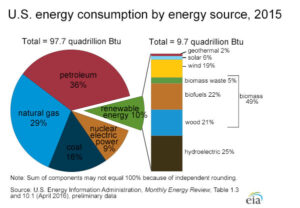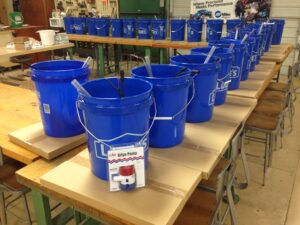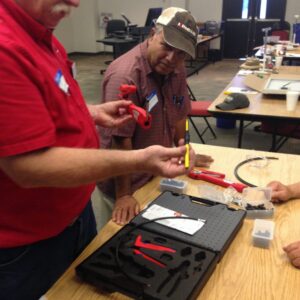Project Overview
Annual Reports
Information Products
Commodities
Practices
- Animal Production: watering systems
- Crop Production: irrigation
- Education and Training: demonstration, workshop, technical assistance
- Energy: solar energy
Abstract:
Our goal for Year Two of this project was to reach out and make up to five (5) face-to-face presentations at county centers located in different regions of the state of Arizona. Unfortunately, due to scheduling difficulties, we were unable to reach our goal. We did conduct two (2) full day-long presentations to cooperative extension groups. The first group was with faculty and staff associated with with Arizona Project WET; a non-profit extension-outreach group providing water education to schools in Arizona. The group had heard about our workshop presentations and expressed interest in learning to incorporate solar photovoltaic water pumping fundamentals into their water festival activities. Staff members from Pima and Maricopa County centers participated in the workshop training. The second workshop was conducted in Yavapai County at the Cooperative Extension office. Attendees included Master Gardener trainees and Cooperative Extension personnel. In an effort to promote the workshop in the northern part of our state, we accepted an invitation to set up a booth with our solar teaching and demonstration materials at a sustainability-themed health & education expo hosted by (name) in Kayenta, Arizona. Local folks were provided an opportunity to view the demonstrations, ask questions about solar photovoltaic energy systems, and receive information about available grants. We continue to contact individual county office personnel to set up dates for spring and summer 2017. We will attempt to add three (3) workshops to our third year of our project.
Workshop Format. A pre-workshop survey was sent out to the participants and a request made for their participation to complete prior to attending the workshop. As an introduction, all workshop participants viewed a powerpoint presentation of a summary of energy sources (both renewable and nonrenewable) and demand sectors (Annual Energy Review)

The information was compiled from the U.S. Energy Information Administration (www.eia.gov) and from the document, Empower Arizona. The purpose is to provide workshop participants with what size of a role renewable energy sources, and specifically solar PV; play in contributing energy on a national level as well as in the state of Arizona. We continue the presentation with a primer on "electricity basics". This was added to the presentation following feedback from our Year One presentations. We learned there needed to be an understanding about how electricity works and the differences between both alternating current (AC) and direct current (DC), and specific terminology including "watts", "volts", "amperes", and "Ohms Law". We covered solar photovoltaic effect, and what is happening in the solar cell with electrons. Solar PV system types, components of systems, and safe use of multimeters in the use of measuring voltage & current, and calculating electrical power rounded out the classroom presentation.
Hands-on activities included working with 20-watt multi-crystalline solar PV modules to create a simple circuit (source to load), a series circuit (two modules connected to a load = voltage is summed; current remains the same), and a parallel circuit ( two modules connected to a load = current is summed; voltage remains the same). Following a demonstration of interpreting information found on the back sheets of solar modules, we had participants assemble and test simple PV-direct water pumping systems using the 20-watt modules, 12 volt DC water bilge pumps, five-gallon buckets, and PVC pipe components to create solar fountains. A solar irradience meter (pyranometers) was used to show participants how to measure solar irradience (W/m2) intensity and the relationship to solar PV module power output. An inclinometer is used to show how module tilt and orientation affects power output. Working in small groups, participants used digital clamp-on multimeters to measure and record DC voltage, and DC current, and compute power output, and see what happens to the flowing water when the module is shaded from direct sunlight.
Finally, all participants collect materials and build their own demonstration systems. Using industry-grade hand tools, participants build PV cable connectors with multi-contact connectors (MC-3) to wire to their solar modules, and separate male (+) and female (-) PV home run leads to connect between their solar module and the 12 volt DC water bilge pumps. In addition to measuring and cutting PVC pipe, and drilling holes in clear PVC pipe each participant collects connectors, tubing, end caps, and wire nuts to assemble a complete working system. Digital clamp-on multimeters to test their demonstration systems, and reference materials. We provide a flashdrive loaded with solar PV curriculum, a copy of a Teaching Solar reference book from the Rahus Institute, and a complimentary copy of Home Power Magazine.
Our goal for Year Three was to schedule and conduct three to four additional summer workshops, and complete large, PV-direct water pumping systems for county centers desiring to have their own large solar-powered water pumping demonstration system. Two county presentations (La Paz, and Santa Cruz County) were made. A workshop was made to volunteer staff members of the Tucson Village Garden (TVG) project, part of the Pima County Cooperative Extension Center, and to staff of Arizona Project WET.
Additionally, a separate workshop was made (by invitation) to an audience of high school agriculture educators during the California Agriculture Teachers Association (CATA) annual Summer Conference at Cal Poly State University in San Luis Obispo. Eight teachers attended the day-long workshop.
Project objectives:
2016 - Year Two
- Reaching out to county extension offices and arranging dates for face-to-face workshop presentations.
- Responding to county extension agents agreeing to have a face-to-face workshop presentation made at their county office.
- Making face-to-face workshop presentations to extension educators, researchers, outreach educators, master gardeners, and 4-H leaders.
- Collect pre-workshop online survey data from workshop participants.
- Conduct hands-on demonstration of safe use of solar PV hand-tools to workshop participants.
- Have workshop participants use hand tools to assemble demonstration solar PV water pumping systems.
- Have workshop participants complete post-workshop survey.


2017 - Year Three
- Hands-on solar energy education workshop conducted for extension educators of La Paz County Cooperative Extension Center in Parker, Arizona.
- Hands-on solar energy education workshop conducted for extension educator, volunteer staff, and science educators attending Santa Cruz County Cooperative Extension workshop in Nogales, Arizona.
- Four (4) solar demonstration workshops were made to high school agriculture science students participating in district-level FFA Agriculture Mechanics Career Development Event (CDE) Team Activity. Workshops were conducted for students at Arizona Western College in Yuma, AZ., Central Arizona College in Casa Grande, AZ., Round Valley High School in Snowflake, AZ., Arizona State University Polytechnic Campus in Mesa, AZ
- An invited solar PV demonstration was made to students and faculty of the Star Charter School in Leupp, AZ on the Navajo Reservation.